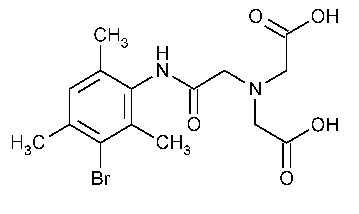Mebrofenin
Glycine,N-[2-[(3-bromo-2,4,6,-trimethylphenyl)amino]-2-oxoethyl]-N-(carboxymethyl)-.
[[[(3-Bromomesityl)carbamoyl]methyl]imino]diacetic acid [78266-06-5].
»Mebrofenin contains not less than 97.0percent and not more than 101.0percent of C15H19BrN2O5,calculated on the dried basis.
Packaging and storage—
Preserve in tight containers.Store at 25 ,excursions permitted between 15
,excursions permitted between 15 and 30
and 30 .
.
Identification,
Infrared Absorption á197Kñ.
Melting range,Class Iá741ñ:
between 185 and 200
and 200 ,but the range between beginning and end of melting does not exceed 4
,but the range between beginning and end of melting does not exceed 4 .
.
Loss on drying á731ñ—
Dry it in vacuum at 100 for 3hours:it loses not more than 0.3%of its weight.
for 3hours:it loses not more than 0.3%of its weight.
Residue on ignition á281ñ:
not more than 0.1%.
Heavy metals,Method IIá231ñ:
0.003%.
Limit of nitrilotriacetic acid—
Mobile phase—
Add 10mLof a 1in 4solution of tetrabutylammonium hydroxide in methanol to 200mLof water,and adjust with 1Mphosphoric acid to a pHof 7.5±0.1.Transfer this solution to a 1000-mLvolumetric flask,add 90mLof methanol,dilute with water to volume,mix,pass through a filter having a 0.5-µm or finer porosity,and degas.Make adjustments if necessary (see System Suitabilityunder Chromatography á621ñ).
Cupric nitrate solution—
Prepare a solution containing about 10mg of cupric nitrate per mL.
Standard stock solution—
Transfer about 25mg of nitrilotriacetic acid,accurately weighed,to a 50-mLvolumetric flask,dilute with dilute ammonium hydroxide (1in 20)to volume,and mix.
Standard solution—
Transfer 10mLof the Standard stock solutionto a 100-mLvolumetric flask,and dilute with Cupric nitrate solutionto volume.[NOTE—Prepare fresh on the day of use.]
Test solution—
Transfer about 250mg of Mebrofenin,accurately weighed,to a 25-mLvolumetric flask,dilute with Cupric nitrate solutionto volume,and mix.Sonicate,if necessary,to achieve complete solution.[NOTE—Prepare fresh on the day of use.]
Chromatographic system(see Chromatography á621ñ)—
The liquid chromatograph is equipped with a 254-nm detector and a 4.6-mm ×25-cm column that contains packing L7.The flow rate is about 0.8mLper minute.Chromatograph the Standard solution,and record the peak responses as directed for Procedure:the resolution,R,between the major peak and any other peak is not less than 1.7.[NOTE—Peaks containing copper may be present.]The relative standard deviation for replicate injections is not more than 2.0%.
Procedure—
Separately inject equal volumes (about 20µL)of the Standard solutionand the Test solutioninto the chromatograph,and record the chromatograms.Measure the responses for the peaks in each chromatogram at the locus for copper nitrilotriacetic acid.Calculate the quantity,in mg,of nitrilotriacetic acid in the portion of Mebrofenin taken by the formula:
25C(rU/rS),
in which Cis the concentration,in mg per mL,of nitrilotriacetic acid in the Standard solution;and rUand rSare the peak responses obtained from the Test solutionand the Standard solution,respectively:not more than 0.1%is found.
Chromatographic purity—
Mobile phase—
Prepare a mixture of equal volumes of 0.025Mmonobasic potassium phosphate and 0.025Mdibasic sodium phosphate.To 400mLof this solution add 600mLof methanol.Adjust the volume to 1000mLwith water,and adjust with 1Nhydrochloric acid to a pHof 5.0±0.1.Make adjustments if necessary (see System Suitabilityunder Chromatography á621ñ).Pass through a filter having a 0.45-µm porosity,and degas.
Test solution—
Transfer about 12.5mg of Mebrofenin,accurately weighed,to a 25-mLvolumetric flask,dilute with Mobile phaseto volume,and mix.
Chromatographic system(see Chromatography á621ñ)—
The liquid chromatograph is equipped with a 220-nm detector and a 4.6-mm ×25-cm column containing packing L1.The flow rate is about 1mLper minute.Chromatograph about 20µLof the Test solution,and record the peak responses.The capacity factor,k¢,is not less than 1.2;and the effective plate number,neff,calculated by the formula 16[(t-ta)/W]2,in which the terms are as defined under Chromatography á621ñ,is not less than 200.The tailing factor is not more than 4.0,and the relative standard deviation of the mebrofenin peak responses for replicate injections is not more than 2.0%.
Procedure—
Chromatograph about 20µLof the Test solution,run the chromatograph for twice the elution time of the mebrofenin peak,and record the peak response for individual impurities and the total response for the entire chromatogram.Calculate the percentage of chromatographic impurities taken by the formula:
100(rs/rt),
in which rsis the sum of the peak responses of the individual impurities;and rtis the total of all of the peak responses in the chromatogram:not more than 3%is found.
Assay—
Dissolve about 100mg of Mebrofenin,accurately weighed,in about 40mLof dimethylformamide in a conical flask,with the aid of sonication if necessary.Add 3drops of thymol blue TS,and titrate with 0.1Nsodium methoxide (in toluene)VSto a blue endpoint while flushing the flask with a gentle stream of nitrogen.Perform a blank determination,and make any necessary correction.Each mLof 0.1Nsodium methoxide is equivalent to 19.36mg of C15H19BrN2O5.
Auxiliary Information—
Staff Liaison:Andrzej Wilk,Ph.D.,Senior Scientific Associate
Expert Committee:(RMI)Radiopharmaceuticals and Medical Imaging Agents
USP28–NF23Page 1190
Pharmacopeial Forum:Volume No.29(6)Page 1923
Phone Number:1-301-816-8305
